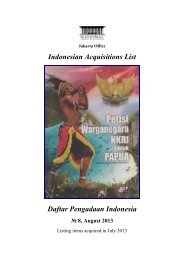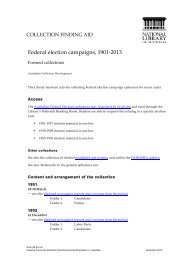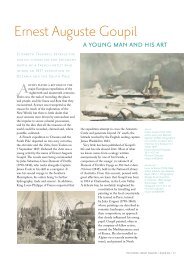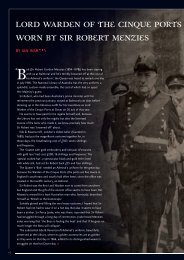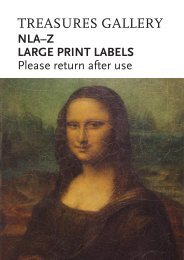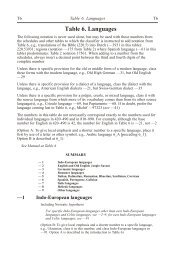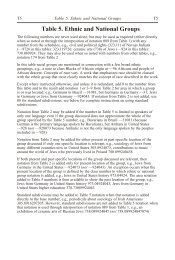Download the National Library Magazine - National Library of ...
Download the National Library Magazine - National Library of ...
Download the National Library Magazine - National Library of ...
You also want an ePaper? Increase the reach of your titles
YUMPU automatically turns print PDFs into web optimized ePapers that Google loves.
Not only a place <strong>of</strong> work, underground<br />
can also be a site <strong>of</strong> domesticity; for many<br />
Australians, it is home. At Coober Pedy in<br />
South Australia, some 850 kilometres from<br />
Adelaide, almost an entire community <strong>of</strong><br />
around 3,000 lives and works underground.<br />
Although <strong>the</strong> existence <strong>of</strong> opals at Coober<br />
Pedy was known from <strong>the</strong> late 1850s, it was<br />
only after 1916 that opal mining took <strong>of</strong>f.<br />
The first opal miners were workers from<br />
<strong>the</strong> Australian east–west transcontinental<br />
railway and also soldiers returning from<br />
<strong>the</strong> First World War, looking for a life <strong>of</strong><br />
independence and, possibly, some wealth.<br />
It is likely that <strong>the</strong> soldiers gave <strong>the</strong> name<br />
‘dugout’ to <strong>the</strong> underground dwellings that<br />
<strong>the</strong>y excavated at Coober Pedy, a term which<br />
was commonly used at <strong>the</strong> front. Soldiers <strong>of</strong><br />
every army knew <strong>the</strong> comfort and security <strong>of</strong><br />
‘dugouts’ on <strong>the</strong> Western Front and, in <strong>the</strong><br />
frighteningly high temperatures at Coober<br />
Pedy, it made sense to burrow into <strong>the</strong><br />
hillsides, just as at Gallipoli.<br />
The homes that <strong>the</strong>se miners dug, at<br />
first <strong>of</strong> course by hand, are in fact caves<br />
bored into <strong>the</strong> hillsides <strong>of</strong> <strong>the</strong> town. People<br />
have fashioned houses in <strong>the</strong>se caves with<br />
bedrooms, living areas and kitchens, just as<br />
we know in our own homes. Most have an<br />
entrance above ground and many also have<br />
front gardens. Unlike in 1916, houses today<br />
can readily be air conditioned and some<br />
miners and o<strong>the</strong>r workers at Coober Pedy<br />
have chosen to live above ground. Even so, a<br />
substantial proportion <strong>of</strong> <strong>the</strong> houses, and two<br />
churches—a Roman Catholic and a Serbian<br />
Orthodox—are still underground. Tourists<br />
who come to Coober Pedy for both <strong>the</strong> opals<br />
and <strong>the</strong> unusual nature <strong>of</strong> <strong>the</strong> town can also<br />
choose underground accommodation, ei<strong>the</strong>r in<br />
an up-market hotel or in budget-style motels<br />
and hostels.<br />
For o<strong>the</strong>rs, making a home under <strong>the</strong><br />
surface has been more a matter <strong>of</strong> necessity<br />
than choice. During <strong>the</strong> Great Depression,<br />
some Australian families, finding <strong>the</strong>mselves<br />
turfed out onto <strong>the</strong> street with <strong>the</strong>ir few<br />
possessions, took up residence in Sydney’s<br />
caves. Today, <strong>the</strong> homeless still turn<br />
to underground bunkers for safety and<br />
shelter, sharing <strong>the</strong>m with those <strong>the</strong>y trust.<br />
Indeed, men and women in Australia have<br />
always shown ingenuity in resorting to <strong>the</strong><br />
underground in times <strong>of</strong> difficulty.<br />
In many ways, underground has become<br />
part <strong>of</strong> our everyday life. Much <strong>of</strong> Australia’s<br />
population now lives in cities in which<br />
underground infrastructure is taken for<br />
granted: we enter basement car parks without<br />
a second thought, hidden sewers take our<br />
waste out <strong>of</strong> sight, tunnels for trains or cars<br />
have become part <strong>of</strong> <strong>the</strong> natural order <strong>of</strong><br />
things. Yet, as <strong>the</strong> popularity <strong>of</strong> <strong>the</strong> tours <strong>of</strong><br />
<strong>the</strong> old Foreign Affairs <strong>of</strong>fices shows, many<br />
Australians still<br />
have a deep-seated<br />
fascination with<br />
<strong>the</strong> underground.<br />
Perhaps it is because<br />
it has an element<br />
<strong>of</strong> <strong>the</strong> ‘underworld’,<br />
<strong>of</strong> mystery, even <strong>of</strong><br />
criminality. It is <strong>the</strong><br />
sense <strong>of</strong> descent into<br />
ano<strong>the</strong>r world that<br />
makes us nervous,<br />
even as we step below.<br />
MICHAEL MCKERNAN<br />
is <strong>the</strong> author <strong>of</strong><br />
more than 20 books,<br />
including Underground<br />
Australia produced by<br />
NLA Publishing<br />
left<br />
Bob Miller (b. 1953)<br />
Coober Pedy: Backpackers Cave<br />
& Opal Cave Dug into Hill. Note<br />
Air Vents & Solar Panels 1994<br />
b&w photograph; 16.4 x 21.5 cm<br />
Pictures Collection<br />
nla.pic-an13180041-4<br />
below<br />
Approach to Cave Dwellers<br />
House near Kurnell, New South<br />
Wales 1930s<br />
b&w photograph; 11.7 x 6.9 cm<br />
Pictures Collection<br />
nla.pic-vn3705987<br />
THE NATIONAL LIBRARY OF AUSTRALIA MAGAZINE :: DECEMBER 2013 :: 15



